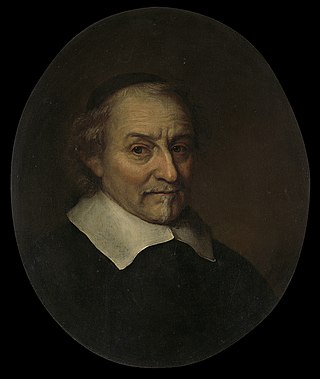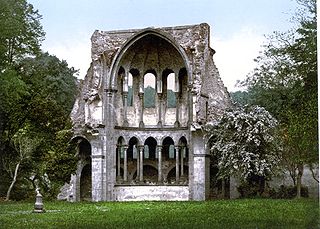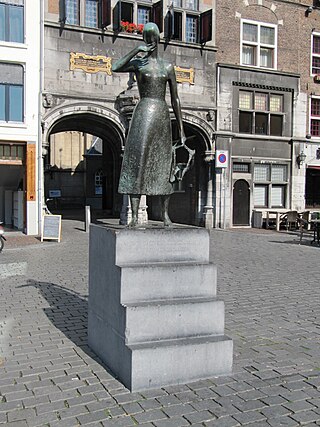
Caesarius of Heisterbach, sometimes erroneously called, in English, Caesar of Heisterbach, was the prior of a Cistercian monastery, Heisterbach Abbey, which was located in the Siebengebirge, near the small town of Oberdollendorf, Germany.

Joost van den Vondel was a Dutch playwright, poet, literary translator and writer. He is generally regarded as the greatest writer in the Dutch language as well as an important figure in the history of Western literature. In his native country, Vondel is often called the “Prince of Poets” and the Dutch language is sometimes referred to as “the language of Vondel”. His oeuvre consists of 33 plays, a large number of poems in different genres and forms, an epic poem and many translations of predominantly classical literature. Vondel lived in the Dutch Republic during the Eighty Years' War and became the leading literary figure of the Dutch Golden Age.

Elckerlijc is a morality play from the Low Countries which was written in Dutch somewhere around the year 1470. It was first printed in 1495. The play was extremely successful and may have been the original source for the English play Everyman, as well as many other translations for other countries. The authorship of Elckerlijc is attributed to Peter van Diest, a medieval writer from the Low Countries.

A double monastery is a monastery combining separate communities of monks and of nuns, joined in one institution to share one church and other facilities. The practice is believed to have started in the East at the dawn of monasticism. It is considered more common in the monasticism of Eastern Christianity, where it is traceable to the 4th century. In the West the establishment of double monasteries became popular after Columbanus and sprang up in Gaul and in Anglo-Saxon England. Double monasteries were forbidden by the Second Council of Nicaea in 787, though it took many years for the decree to be enforced. Double monasteries were revived again after the 12th century in a significantly different way when a number of religious houses were established on this pattern among Benedictines and possibly the Dominicans. The 14th-century Bridgittines were purposely founded using this form of community.

Hubertus Gerardus Josephus Henricus "Huub" Oosterhuis was a Dutch theologian and poet. He is mainly known for his contribution to Christian music and liturgy in Dutch and also in German, used in both Protestant and Catholic churches. He authored over 60 books and over 700 hymns, songs, psalms, and prayers. Several of his songs were translated, and he received international awards and recognition.
"The Summoner's Tale" is one of The Canterbury Tales by Geoffrey Chaucer.
Flemish literature is literature from Flanders, historically a region comprising parts of present-day Belgium, France and the Netherlands. Until the early 19th century, this literature was regarded as an integral part of Dutch literature. After Belgium became independent from the Netherlands in 1830, the term Flemish literature acquired a narrower meaning and refers to the Dutch-language literature produced in Belgium. It remains a part of Dutch-language literature.
Middle Dutch literature (1150–1500) is the Dutch literature produced in the Low Countries from the 12th century to the 16th century. It is preceded by only a few fragmentary texts existing in Old Dutch, and it was succeeded by Dutch Renaissance and Golden Age literature.

Lucebert was a Dutch artist who first became known as the poet of the COBRA movement.

Beatrice of Nazareth, also known as Beatrice of Tienen, was a Flemish Cistercian nun, visionary and mystic. Remembered chiefly through a medieval adaptation of her writings, of which the originals are now mostly lost, she is venerated as Blessed by the Catholic Church.

Heisterbach Abbey was a Cistercian monastery in the Siebengebirge near Oberdollendorf in North Rhine-Westphalia, Germany.

M. Vasalis, was a Dutch poet and psychiatrist.
Johannes Hartlieb was a physician of Late Medieval Bavaria, probably of a family from Neuburg an der Donau. He was in the employment of Louis VII of Bavaria and Albert VI of Austria in the 1430s, and of Albert III of Bavaria from 1440, and of the latter's son Sigismund from 1456. In 1444, he married Sibilla, possibly the daughter of Albert and Agnes Bernauer. Hartlieb wrote a compendium on herbs in ca. 1440, and in 1456 the puch aller verpoten kunst, ungelaubens und der zaubrey on the artes magicae, containing the oldest known description of witches' flying ointment. Hartlieb also produced German translations of various classical and medieval authors.

Folklore of the Low Countries, often just referred to as Dutch folklore, includes the epics, legends, fairy tales and oral traditions of the people of Belgium, Netherlands and Luxembourg. Traditionally this folklore is written or spoken in Dutch or in one of the regional languages of these countries.

Erentrude was a saint and abbess, born during the end of the 7th century, probably in present-day Germany or Austria. She was born into a Franconian-Merovingian royal house, and was the niece of Rupert of Salzburg. She left her home country to assist Rupert in establishing religious communities in Salzburg; in about 700, he built a convent, Nonnberg Abbey, and installed her as its first abbess. She and the nuns at Nonnberg served the poor, needy, and ill, striking a balance between living as cloistered nuns and engaging in charitable works. Erentrude died on 30 June 718. Her fame for healing miracles and intercession grew after her death, and many legends have arisen throughout the centuries since her death. In 2006, Erentrude's image appeared on the Austrian Nonnberg Abbey commemorative coin. Her feast day is celebrated on 30 June.

Elegast is the hero and noble robber in the poem Karel ende Elegast, an early Middle Dutch epic poem that has been translated into English as Charlemagne and Elbegast. In the poem, he possibly represents the King of the Elves. He appears as a knight on a black horse, an outcast vassal of Charlemagne living in the forest. The original Dutch poem uses the name Elegast, while translated versions of the poem commonly use the name Elbegast in German and English, or Alegast in the Scandinavian ballad.

Brecht Abbey, also known as the Abbey of Our Lady of Nazareth, is an abbey of Trappistine nuns located in Brecht, in the Campine region of the province of Antwerp. Life in the abbey is characterized by prayer, reading and manual work, the three basic elements of Trappist life.

Mariken van Nieumeghen is a miracle play recorded in a Middle Dutch text from the early 16th century. The protagonist Mariken of the story spends seven years with the devil, after which she is miraculously released. The oldest edition dates from 1515 and was printed by Willem Vorsterman. Linguistic evidence suggests it was written by a poet from an Antwerp chamber of rhetoric.

Marie "Rie" Cramer was a Dutch writer and prolific illustrator of children's literature whose style is considered iconic for the interwar period. For many years, she was one of the two main illustrators for a leading Dutch youth magazine, Zonneschijn (Sunshine). She also wrote plays under the pseudonym Marc Holman. Some of her work was banned during World War II because it attacked National Socialism, and she wrote for a leading underground newspaper during the war.

Lucretia Wilhelmina van Merken was a Dutch poet and playwright. Born in Amsterdam, she began writing occasional poetry and in her early twenties had published her first tragedy. Influenced by the Enlightenment, her tragedies were classicist in style and proved to be popular, being performed all over the country. She wrote an ode in French for George Washington, and sent it to him, and for the revised Dutch version of the Book of Psalms she provided seventeen of the psalms.
















